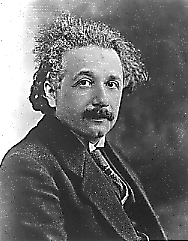Click on image for full size
Courtesy of Tracey Keifer. Emilio Segre Visual Archives. American Institute of Physics.
It Looks Like Einstein Was Right! Speed of Light and Gravity are Equal!
News story originally written on January 9, 2003
To make his most well-know theory, the General Theory of Relativity, physicist Albert Einstein had to guess that the speed of gravity was equal to the speed of light. Now, scientists have found that he was likely right!
In 1915, Einstein developed his General Theory of Relativity to explain how gravity and motion can affect time and space, proposing that matter causes space to curve. Today, Einstein’s theory is very important for many scientists trying to understand the Universe and the Big Bang.
His theory assumes that the force of gravity acts at the same speed as the speed of light. Until recently this assumption had not been tested thoroughly. While the speed of light has been measured as 299,800 km/sec, scientists found that it is very difficult to accurately measure the speed of gravity. Einstein's assumption appeared to be true, based on indirect evidence, but it had never been comprehensively tested before now.
Scientists had the opportunity to test this assumption of Einstein's theory when, on September 8, 2002, Jupiter passed in front of a distant quasar called J0842. This week they released their findings at the meeting of the American Astronomical Society in Seattle, WA. They reported that the planet’s gravity bent the quasar’s radio waves, making the quasar appear to move in an elliptical shape through the sky according to the observations of many radio telescopes in the United States and Germany. From the shape of the quasar’s motion, the scientists calculated that the speed of gravity is nearly the same as the speed of light!















